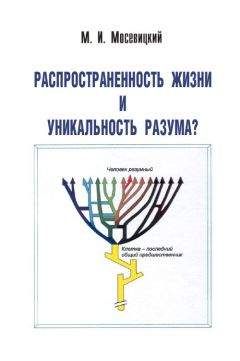Марк Мосевицкий - Распространненость жизни и уникальность разума?

Помощь проекту
Распространненость жизни и уникальность разума? читать книгу онлайн
Poole A. et al. (1999) Early evolution: prokaryotes, the new kids on the block. Bi―ssais, 21, 880―889.
Poole A. M. and Logan D. T. (2005) Modern mRNA proofreading and repair: clues that the last universal common ancestor possessed an RNA genome? Mol. Biol. Evol., 22, 1444―1455.
Pope K. O. et al. (1994) Impact winter and the Cretaceous/Tertiary extinctions: results of a Chicxulub asteroid impact model. Earth Planet Sci. Lett., 128, 719―725.
Pope K. O. et al. (1997a) Surface expression of the Chicxulub crater. Geology, 25, 567―598.
Pope K. O. et al. (1997b) Energy, volatile production, and climatic effects of the Chicxulub Cretaneous/Tertiary impact. J. Geophys. Res., 102, 21645―21664.
Poreda R. J. and Becker L. (2003) Fullerenes and interplanetary dust at the Permian-Triassic boundary. Astrobiology, 3, 75―90.
Price D. L. et al. (1998) Alzheimer disease ― when and why? Nature Gen., 19, 314―316.
Pu L. et al. (1977) Preliminary study on the age of Yuanmou man by palaeomagnetic technique. Sci. Sin., 20, 645―664.
Quintana-Murci L. et al. (1999) Genetic evidence of an early exit of Homo sapiens sapiens from Africa through eastern Africa. Nat. Genet., 23, 437―441.
Rabinowitz D. et al. (2000) A reduced estimate of the number of kilometre-sized near-Earth asteroids. Nature, 403, 165―166.
Ramakrishnan U. et al. (2005) Detecting past population bottlenecks using temporal genetic data. Mol. Ecol., 14, 2915―2922.
Rasmussen B. (2000) Filamentous microfossils in a 3,235-million-year-old volcanogenic massive sulphide deposit. Nature, 405, 676―679.
Rasmussen S. et al. (2003) Bridging nonliving and living matter. Artif. Life, 9, 269―316.
Rasmussen S. et al. (2004) Transitions from nonliving to living matter. Science, 303, 963―965.
Raulin F. and Greenberg J. M. (1997) From the interstellar clouds, through the inner to the outer solar system: a universally distributed complex organic chemistry. Preface. Adv. Space Res., 19, 975―978.
Ravizza G. et al. (2003) Chemostratigraphic evidence of Deccan volcanism from the marine osmium isotope record. Science, 302, 1392―1395.
Ray N. et al. (2005) Recovering the geographic origin of early modern humans by realistic and spatially explicit stimulation. Genome Res. 15, 1161―1167.
Razin S. V. et al. (1985) Low ionic strength extraction of nuclease-treated nuclei destroys the attachment of transcriptionally active DNA to the nuclear skeleton. Nucl. Acids Res., 13, 7427―7444.
Reichow M. K. et al. (2002) 40Ar/39Ar dates from the West Siberian Basin: Siberian flood basalt province doubled. Science, 296, 1846―1849.
Reiss A. L. et al. (1995) Contribution of the FMR1 gene mutation to human intellectual disfunction. Nat. Genet., 11, 331―334.
Relethford J. H. (2001) Ancient DNA and the origin of modern humans. Proc. Natl. Acad. Sci. USA, 98, 390―391.
Rettberg P. et al. (2002) Survival of microorganisms in space protected by meteorite material: results of the experiment fiEXOBIOLOGIEfl of the PERSEUS mission. Adv. Space Res. 30, 1539―1545.
Ribeiro S. and Golding G. B. (1998) The mosaic nature of the eukaryotic nucleus. Mol. Biol. Evol., 15, 779―788.
Richards M. (2004) Perfecting people: selective breeding at the Oneida Community and eugenics movement. New Genet. Soc., 23, 47―71.
Rightmire G. P. (1998) Evidence from facial morphology for similarity of Asian and African representatives of Homo erectus. Am. J. Phys. Antropol., 106, 61―85.
Rightmire G. P. et al. (2006) Anatomical descriptions, comparative studies and evolutionary significance of the hominin skulls from Dmanisi, Republic of Georgia.
J. Hum. Evol., 50, 115―141.
Rivera M. C. and Lake J. A. (2004). The ring of life provides evidence for a genome fusion origin of eukariotes. Nature, 431, 152―155.
Rosa L. P. and Faber J. (2004) Quantum models of the mind: are they compatible with environment decoherence? Phys. Rev. E Stat. Nonlin. Soft Matter Phys., 70, 031902.
Rossignol-Strick M. and Barghoorn E. S. (1971) Extraterrestrial abiogenic organization of organic matter: the hollow spheres of the Orgueil meteorite. Space Life Sci., 3, 89―107.
Rossini P. M. and Rossi S. (2007) Transcranial magnetic stimulation: diagnostic, therapevtic, and research potential. Neurology, 68, 484―488.
Routtenberg A. (2000) Enhanced learning after geneticoverexpressionof a brain growth protein. Proc. Natl. Acad. Sci. USA, 97, 7657―7662.
Rowold D. J. et al. (2007) Mitochondrial DNA geneflow indicates preferred usage of the Levant Corridor over the Horn of Africa passageway. J. Hum. Genet., 52, 436―447.
Rujescu et al. (2003) M129V variation in the prion protein may influence cognitive performance. Mol. Psychiatry, 8, 937―941.
Rushton J. P. et al. (2007) No evidence that polymorphisms of brain regulator genes Microcephalin and ASPM are associated with general mental ability, head circumference or altruism. Biol. Lett., 3, 157―160.
Sabeti P. C. et al. (2007) Genome-wide detection and characterization of positive selection in human populations. Nature, 449, 913―918.
Sagan C. et al. (1993) A search for life on Earth from the Galileo spacecraft. Nature, 365, 715―721.
Saghatelian A. et al. (2001) A chiroselective peptide replicator. Nature, 409, 797―801.
Satta Y. and Takahata N. (2002) Out of Africa with regional interbreeding? Modern human origins. Bi―ssays, 24, 871―875.
Savulescu J. (2001) Procreative beneficience: why we should select the best children. Bi―thics, 15, 413―426.
Saxena S. (2003) Small RNAs with imperfect match to endogenous mRNA repress translation. Implications for off-target activity of small inhibitory RNA in mammalian cells. J. Biol. Chem., 278, 44312―44319.
Schidlowski M. (1992) The initiation of biological processes on Earth: summary of empirical evidence. Adv. Space Res., 12, 143―156.
Schidlowski M. (1995) Isotope fractionations in the terrestrial carbon cycle: a brief overview. Adv. Space Res., 15, 441―449.
Schlesinger G. and Miller S. L. (1983) Prebiotic synthesis in atmospheres containing CH4, CO, and CO2. II. Hydrogen, cyanide, formaldehyde and ammonia. J. Mol. Evol., 19, 383―390.
Scholz M. et al. (2000) Genomic differentiation of Neanderthals and anatomically modern man allows a fossil-DNA-based classification of morphologically indistinguishable hominid bones. Am. J. Hum. Genet., 66, 1927―1932.
Schopf J. W. (1993) Microfossils of the Early Archean Apex Chert: New Evidence of the Antquity of Life. Science, 260, 640―646.
Schopf J. W. (1999) Deep divisions in the Tree of Life―what d―s the fossil record reveal? Biol. Bull., 196, 351―353; discussion 354―355.
Schopf J. W. (2006) Fossil evidence of Archaean life. Philos. Trans. R. Soc. Lond.
B. Biol. Sci., 361, 869―885.
Schopf J. W. and Barghoorn E. S. (1967) Alga-like fossils from the Early Precambrian of South Africa. Science, 156, 508―512.
Schopf J. W. and Packer B. M. (1987) Early Archean (3.3-billion to 3.5-billion-year-old) microfossils from Warrawoona Group, Australia. Science, 237, 70―73.
Schrag D. P. et al. (2001) Life, geology and snowball Earth. Nature, 409, 306.
Schulze T. G. et al. (2004) From degeneration to genetic susceptibility, from eugenics to genethics, from Bezugsziffer to LOD score: the history of psychiatric genetics. Int. Rev. Psych., 16, 246―259.
Schurr T. G. and Sherry S. T. (2004) Mitochondrial DNA aandd Y chromosome diversity and the peopling of the Americans: evolutionary and demographic evidence. Am. J. Hum. Biol., 16, 420―439.
Schuster P. (1993). RNA based evolutionary optimization. Orig. Life Evol. Biosph., 23, 373―391.
Schwartz A. W. (1997) Speculation on the RNA precursor problem. J. Theor. Biol., 187, 523―527.
Scott E. R. (1999) Origin of carbonate-magnetite-sulfide assemblages in Martian meteorite ALH84001. J. Geophys. Res., 104, 3803―3813.
Sears D. W. and Kral T. A. (1998) Martian fimicrofossilsfl in lunar meteorites? Meteorit Planet Sci., 33, 791―794.
Segre D. et al. (2001) The lipid world. Orig. Life Evol. Biosph., 31, 119―145.
Selden S. (2005) Transforming better babies into fitter families: archival resourses and the history of American eugenics movement, 1908–1930. Proc. Am. Philos. Soc., 149, 199―255.
Serre D. et al. (2004) No evidence of neandertal mtDNA contribution to early modern humans. PLoS Biology, 2, 313―317.
Servin J.A. et al. (2008) Evidence excluding the root of the tree of life from the actinobacteria. Mol. Biol. Evol., 25, 1―4.
Shang H. et al. (2007) An early modern human from Tianyuan Cave, Zhoukoudian, China. Proc. Natl. Acad. Sci. USA, 104, 6573―6578.
Shapiro R. (1984) The improbability of prebiotic nucleic acid synthesis. Orig. Life, 14, 565―570.
Shapiro R. (1988) Prebiotic ribose synthesis: a critical analysis. Orig. Life Biol. Biosph., 18, 71―85.
Shapiro R. (1999) Prebiotic cytosine synthesis: a critical analysis and implications for origin of life. Proc. Natl. Acad. Sci. USA, 96, 4396―4401.
Sharpton V. L. et al. (1993) Chcxulub multiring impact basin: seize and other characteristics derived from gravity analysis. Science, 261, 1564―1567.
Sharpton V. L. and Marin L. E. (1997) The Cretaceous-Tertiary impact crater and cosmic projectile that produced it. Ann. N.Y. Acad. Sci., 822, 353―380.
Shaw P. et al. (2006) Intellectual ability and cortical development in children and adolescents. Nature, 440, 676―679.
Shen C. et al. (1990) Prebiotic synthesis of histidyl-histidine. J. Mol. Evol., 31, 175―179. Shen G. et al. (2001) High-precision U-series dating of Locality 1 at Zhoukoudian, China. J. Hum. Evol., 41, 679―688.
Shen G. et al. (2002). U-Series dating of Liujiang hominid site in Guangxi Southern China. J. Hum. Evol., 43, 817―829.
Shen Y. (2001) Isotopic evidence for microbial sulphate reduction in the early Archaean era. Nature, 410, 77―81.
Shi P. et al. (2006) Did brain-specific genes evolve faster in humans than in chimpanzees? Trends Genet., 22, 608―613.
Sh―nberg R. et al. (2002) Tungsten isotope evidence from approximately 3.8-Gyr metamorphosed sedimentsfor early meteorite bombardment of the Earth. Nature, 418, 403―405.
Shuttleworth-Edwards et al. (2004) Cross-cultural effects on IQ test performance: a review and preliminary normative indications on WAIS-III test performance. J. Clin. Exp. Neuropsychol., 26, 903―920.
Sievers D. and von Kiedrovski G. (1994) Self-replication of complementary nucleotide-based oligomers. Nature, 369, 221―224.
Sigurdsson H. et al. (1991). Glass from the Cretaceous/Tertiary boundary in Haiti. Nature, 349, 482―487.
Simonson A. B. et al. (2005) Decoding the genomic tree of life. Proc. Natl. Acad. Sci. USA, 102, 6608―6613.
Sinkovics J. G. (2001) The place of viruses in the fitree of lifefl. Acta Microbiol. Immunol. Hung., 48, 115―127.
Skophammer R. G. et al. (2007) Evidence for a gram-positive, eubacterial root of the tree of life. Mol. Biol. Evol., 24, 1761―1768.
Sleep N. H. et al. (2001) Initiation of clement surface conditions on the earliest Earth. Proc. Natl. Acad. Sci. USA, 98, 3666―3672.
Smith C. U. (2007) The fihard problemfl and the quantum physicists. Part 2: Modern times. Brain Cogn., Oct. 22.
Smith D. and Yarus M. (1989) tRNA-tRNA interactions within cellular ribosomes. Proc. Natl Acad. Sci. USA, 86, 4397―4401.
Speicer R. A. (1989) Plants of the Cretaceous-Tertiary boundary. Phil. Trans. R. Soc. Lond. B, 325, 291―305.
Spirin A. S. (2004) The ribosome as an RNA-based molecular machine. RNA Biol., 1, 3―9.
Spiteri E. et al. (2007) Identification of the transcriptional targets of FOXP2, a gene linked to speech and language, in developing human brain. Am. J. Hum. Genet., 81, 1144―1157.
Spray J. G. et al. (1998) Evidence for a late Triassic multiple impact event on Earth. Nature, 392, 171―173.
Starikovskaya Y. et al. (1998) mtDNA diversity in Chukchi and Siberian Eskimos: implications for the genetic history of Ancient Beringia and the peopling of the New World. Am. J. Hum. Genet., 63, 1476―1491.
Steele A. (1998) Atomic force microscopy imaging of fragments from the Martian meteorite ALH84001. J Microsc. 189, 2―7.
Steiper M. E. and Young N. M. (2006) Primate molecular divergence dates. Mol. Phylogenet. Evol., 41, 384―394.
Sternberg R. J. et al. (2005) Intelligence, race, and genetics. Am. Psychol., 60, 46―59. Stern R. and Woods C. G. (2006) Evolutionary Genetics: is brain evolution still continuing in modern humans? Eur. J. Hum. Genet., 14, 799―800.
Stewart S. A. and Allen P. J. (2002) A 20-km-diameter multi-ringed impact structure in the North Sea. Nature, 418, 520―523.
St. George-Hyslop P. H. and Petit A. (2005) Molecular biology and genetics of Alzheimer™s disease. C. R. Biol., 328, 119―130.
Stringer C. (2002) Modern human origins: progress and prospects. Philos. Trans. R. Soc. Lond. B. Biol. Sci., 357, 563―579.
Strom R. G. et al. (2005) The origin of planetary impactors in the inner solar system. Science, 309, 1847―1850.
Summers D. P. and Chang S. (1993) Prebiotic ammonia from reduction of nitrite by iron (II) on the early Earth. Nature, 365, 630―633.
Sun C. et al. (2006) The dazzing array of basal branches in the mtDNA macrohaplogroup M from India as inferred from complete genomes. Mol. Biol. Evol., 23, 683―690.
Swisher C. C. et al. (1994) Age of the earliest known hominids in Java, Indonesia. Science, 1994, 263, 1118―1121.
Tagle R. and Claeys P. (2004) Comet or asteroid shower in the late Eocene? Science, 305, 492.
Taillades J. et al. (1998) N-carbamoyl-б-amino acids rather than free б-amino acids formation in the primitive hydrosphere: a novel proposal for the emergence of prebiotic peptides. Origins Life Evol. Biosphere, 28, 61―77.
Tang K. et al. (2007) A New Approach for Using Genome Scans to Detect Recent Positive Selection in the Human Genome. PLoS Biol., 5, 1587―1602.
Tarter J. C. et al. (2007) A reappraisal of the habitability of planets around M dwarf stars. Astrobiology, 7, 30―65.
Terao Y. and Ugawa Y. (2002) Basic mechanisms of TMS. J. Clin. Neurophysiol., 19, 322―343.
Terhune C. E. et al. (2007) Variation and diversity in Homo erectus: a 3D geometric morphometric analysis of the temporal bone. J. Hum. Evol., 53, 41―60.
Tessier-Lavigne M. and Goodman C. S. (1996) Molecular biology of axon guidance. Science, 274, 1123―1133.
Thomas-Keprta K. L. et al. (2002) Magnetofossils from ancient Mars: a robust biosignature in the martian meteorite ALH84001. Appl. Environ. Microbiol., 68, 3663―3672.
Tian F. et al. (2005) A hydrogen-rich early Earth atmosphere. Science, 308, 1014―1017. Tice M.M. and Lowe D. R. (2004) Photosynthetic microbial mats in the 3, 416-Myr-old ocean. Nature, 431, 549―552.
Tiemei C. et al. (1994) Antiquity of Homo sapiens in China. Nature, 368, 55―56. Timoffejev B. W. (1963) Lebensspuren in meteoriten; resultaten einer microphytologischen analyse. Grana Palynol., 4, 92―99.
Timpson N. et al. (2007) Comment on papers by Evans et al. and Mekel-Bobrov et al. on Evidence for Positive Selection of MCPH1 and ASPM. Science, 317, 1036.
Tishkoff S. A. et al. (2000) Short tandem-repeat polymorphism/alu haplotype variation at the PLAT locus: implications for modern human origins. Am. J. Hum. Genet., 67, 901―925.




![Rick Page - Make Winning a Habit [с таблицами]](/uploads/posts/books/no-image.jpg)




















